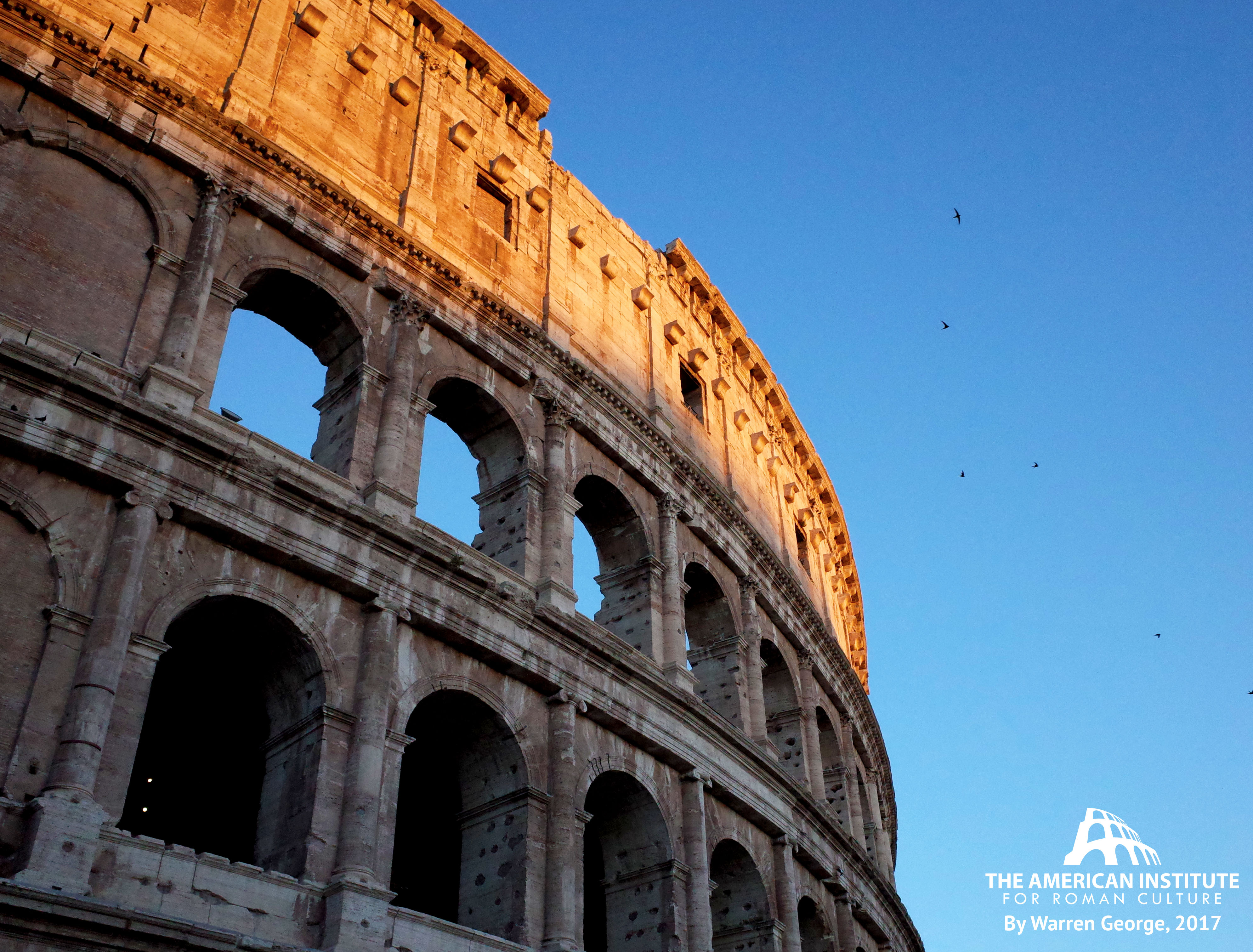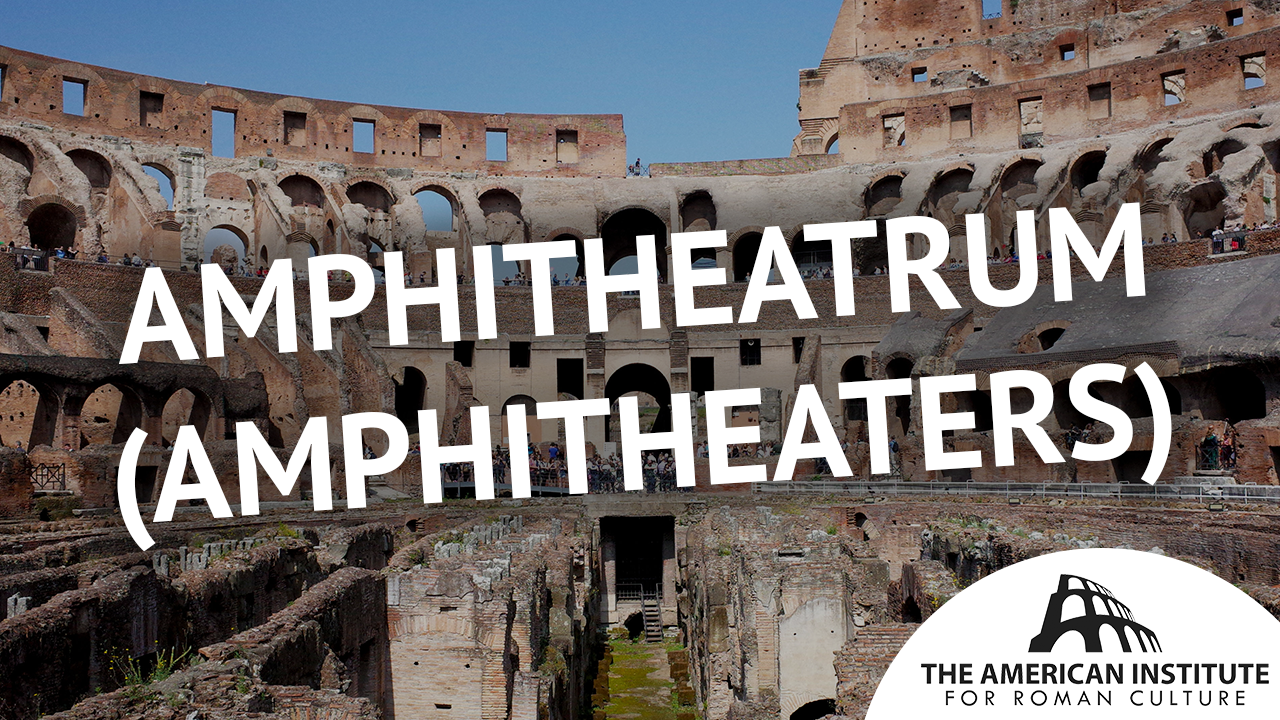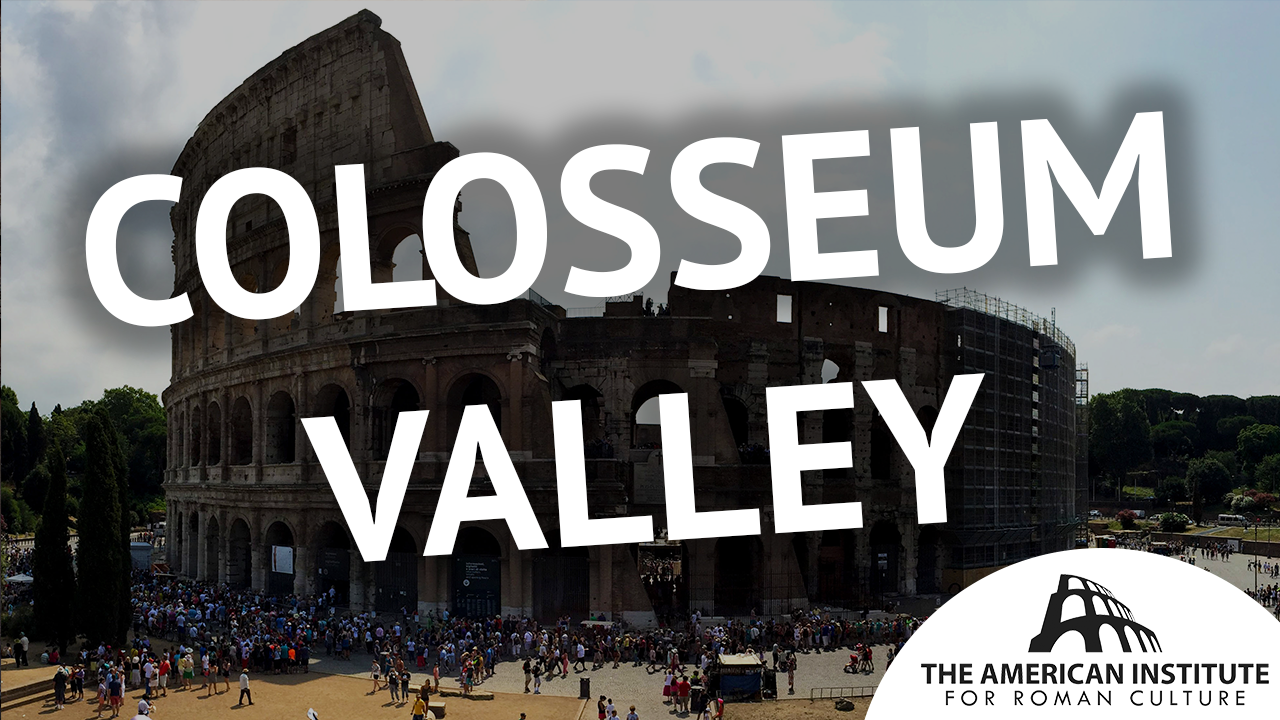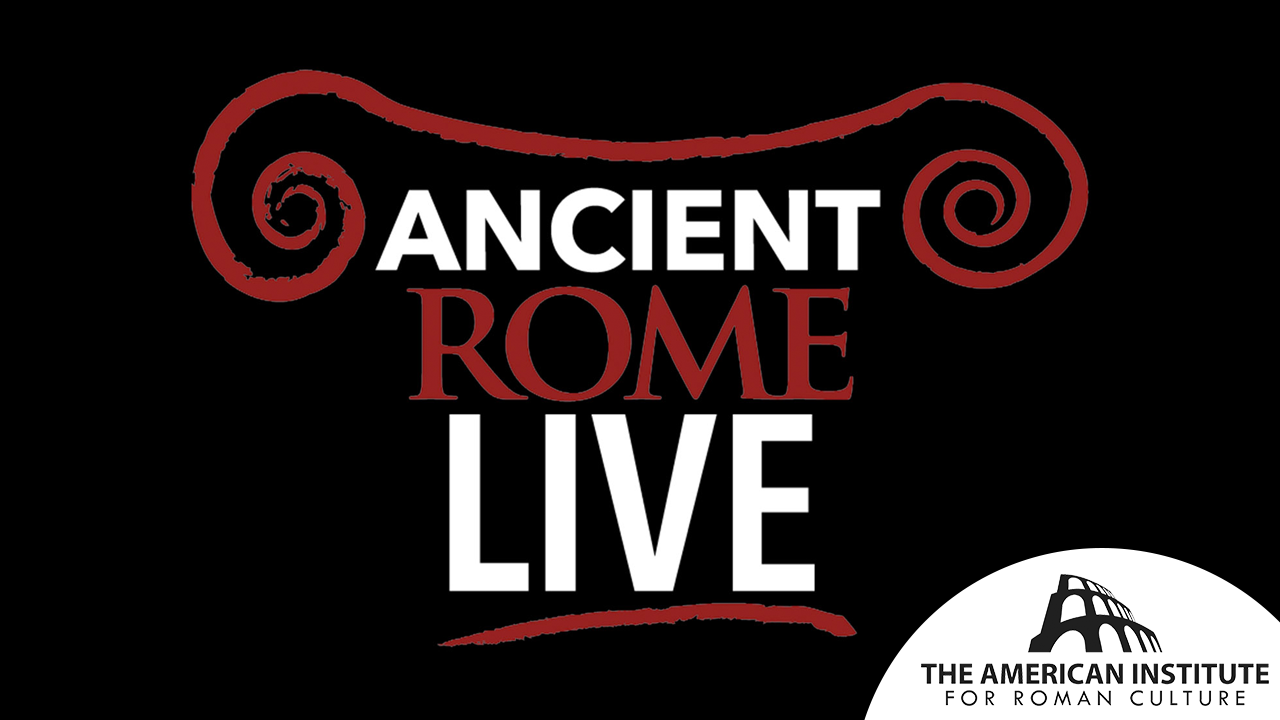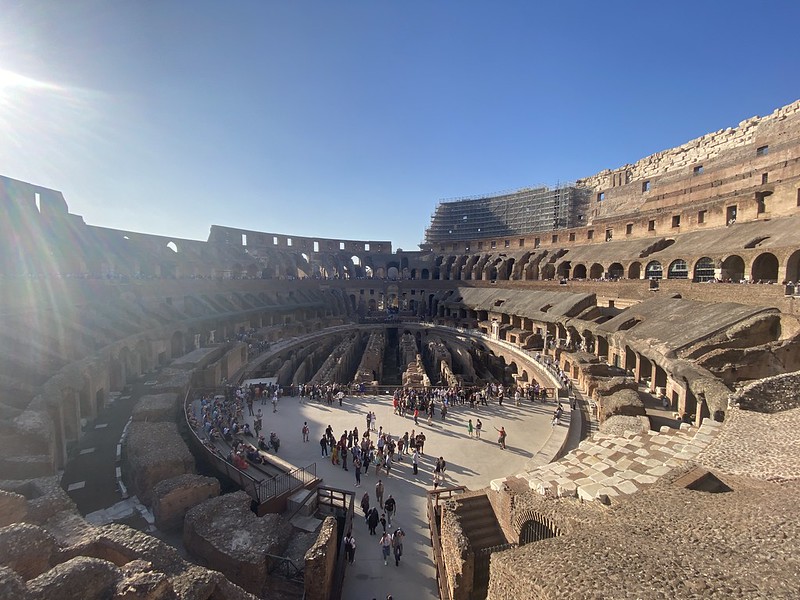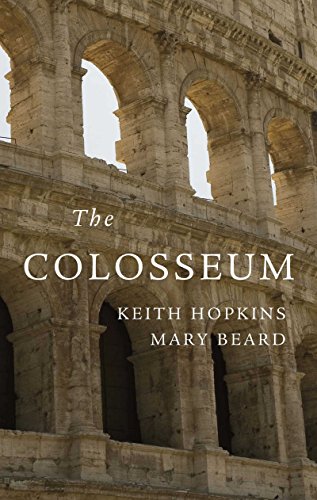Start with our video overviews:
The Colosseum, known in antiquity as the New Amphitheatre, is an architectural legacy of the Flavian imperial dynasty with a history spanning almost two thousand years. When intact, the structure could hold at least 50,000 spectators, with an outer perimeter that spanned 545 meters. Archaeological traces of a day at the games endure, such as remains of snacks (like fruit seeds) and graffiti of the events drawn by onlookers. Spectators were divided by status with the emperor and vestal virgins assigned an honorary box, parallel to images of the gods, and the senatorial class on the same level in their own seats, some of which remain labeled. The higher the seat, the lower the class of spectator: knights sat above senators, and plebeians above knights; finally, 50 meters above the arena floor crowded the common poor, slaves, and women who took the risk of joining them in a standing gallery. All spectators, however, sat high above the gladiators and condemned criminals who lost their lives in the arena, an estimated total of 400,000 over four centuries.
Construction began in 70 CE funded by the spoils from the Temple of Jerusalem. The Emperor Vespasian oversaw the first three levels until he died in 79 CE; his son and successor, Titus, completed the fourth level and inaugurated the amphitheater in 80 CE with 100 successive days of games consisting of hunts, executions, and gladiatorial combat. The third and final Flavian emperor, Domitian, added the now-exposed tunnels used for the transportation of animals and enslaved persons beneath the arena floor.
Stone amphitheaters represented an architectural type just over a century old in Rome when the Colosseum was constructed. The first permanent theater in the Roman world was built in 70 BCE in Pompeii, with Pompey’s unprecedented theater in the city of Rome following 15 years later. The structure evolved from the temporary venues installed for games in the centuries prior. The first gladiatorial games recorded in Rome were in 264 BCE, but they often took place in the Roman Forum as part of ceremonies in honor of the deceased. The elliptical shape of the wooden seats arranged around the spectacles was maintained when permanent theaters became popular in the imperial period.
Though not apparent today, the Colosseum did not stand in striking isolation in antiquity: four gladiatorial schools, an armory, a hospital, a morgue, and storage spaces for elaborate stage sets were built nearby. The area was previously part of Nero’s Domus Aurea. Due to the ultimate unpopularity of Nero, the Flavians publicly reversed many of his actions, including draining the artificial lake in the center of his residential complex and replacing it with the Colosseum. It is believed that the Colosseum derives its name from the colossal statue of Nero erected in the area that was later transformed to represent the sun god Apollo.
The Colosseum was used for four centuries as a theater, despite several disasters, including fires and earthquakes. The last gladiatorial games were held in 434 and the last hunts in 523: from that time, a church was installed, and the early medieval population took over the space for living and working. The most significant damage occurred during an earthquake in the 14th century, which destroyed the south side of the structure and catalyzed the recycling of raw materials from the site. The abandoned area became overgrown, with 420 species of plants recorded in the 19th century, when efforts to clear and conserve the monument began.
Bibliography
- Claridge, “Rome: An Oxford Archaeological Guide”, (Oxford 2010).
- Marconi, “The Oxford Handbook of Greek and Roman Art and Architecture”, (Oxford 2018).
- E. Welch, “The Roman Amphitheatre: From its Origins to the Colosseum”, (Cambridge 2007).
- C. Lancaster, “The Process of Building the Colosseum: The Site, Materials and Construction Techniques”, Journal of Roman Archaeology, (2005), 57-82.
Read More
Funded by the conquest of Judaea, and potentially built by slaves from that war, the Colosseum was made up of travertine limestone, tuff and brick-faced concrete. It is estimated that the Colosseum could hold between 50,000 and 80,000 spectators, probably averaging around 65,000. In AD 217 it was struck by lightning according to Cassius Dio, and thus suffered major fire damage, destroying the wooden portions of the upper interior. This damage was not fully repaired until 240, though it then underwent more repairs in the 250s and in 320. Under the emperor Honorius, gladiator fights were banned in both AD 399 and 404, and more repairs took place throughout the 5th and early 6th centuries. The 6th century is also when we hear of the last of the contests in the Colosseum, with animal hunts being held by Anicius Maximus to celebrate his consulship. The Colosseum had a variety of uses post-antiquity, between the 6th and 12th centuries, there were shops and houses in the arcades, a small chapel had been built within the architecture, and the arena was a cemetery. The Frangipani family took control of the Colosseum in the 12th century and fortified it to turn it into a sort of castle. The outer south side collapsed in a 14th century earthquake, a lot of the stone and marble stripping of the monument took place during the years following this incident. It wasn’t until Pope Benedict XIV in the 18th century that Romans were forbidden from using the Colosseum as a quarry. Subsequent popes and rulers have sought to stabilise and reinforce the monument, with the whole area being excavated under Mussolini. Today the Colosseum received around 7 million visitors a year. The hypocaust has had a path installed so visitors can walk through the underground section, a (admittedly controversial) plan is now in place to rebuild the entire arena floor, and make it retractable) so that shows can be held there, and it received a Lego set version at the end of 2020, making it the second of Rome’s monuments to be Lego-fied after the Trevi Fountain.
AMPHITHEATRUM FLAVIUM, ordinarily known as the Colosseum,1 built by Vespasian, in the depression between the Velia, the Esquiline and the Caelian, a site previously occupied by the stagnum of Nero’s domus Aurea (Suet. Vesp. 9; Mart. de spect. 2. 5; Aur. Vict. Caes. 9. 7). Vespasian carried the structure to the top of the second arcade of the outer wall and of the maenianum secundum of the cavea (see below), and dedicated it before his death in 79 A.D. (Chronogr. a. 354, P. 146). Titus added the third and fourth stories2 (ib.), and celebrated the dedication of the enlarged building in 80 with magnificent games that lasted one hundred days (Suet. Titus 7; Cass. Dio lxvi. 25; Hieron. a. Abr. 2095; Eutrop. vii. 21; Cohen, Tit. 399, 400). Domitian is said to have completed the building ad clipea (Chron. ib.) which probably refers to the bronze shields that were placed directly beneath the uppermost cornice (cf. Cohen, Tit. 399) and to additions on the inside 3 (HJ 282).
Read More
There are indications of changes or additions by Nerva and Trajan(CIL vi. 32254-5; for the inscription of the former see Spinazzola, Anfiteatro Flavio (Naples, 1907) 27 sqq.), and it was restored by Antoninus Pius (Hist. Aug. Pius 8). In 217 it was struck by lightning (Cass. Dio lxxviii. 25), and so seriously damaged that no more gladiatorial combats could be held in the building until 222-223, when the repairs begun by Elagabalus (Hist. Aug. Elagab. 17) were at least partially completed by Alexander Severus (Hist. Aug. Alex. Sev. 24; Cohen, Alex. Sev. 468, 469), although they seem to have continued into the reign of Gordianus III (Hist. Aug. Max. et Balb. i. 4; Cohen, Gord. III. 165, 166). In 250 the building was presumably restored by Decius, after a fire caused by another stroke of lightning (Hieron. a. Abr. 2268). It was injured by the earthquake of 442 (Paul. Diac. hist. Rom. xiii. 16; BC 1917, 13-17), and restorations by different officials are recorded in the years immediately succeeding (CIL vi. 32086-32089), and again in 470 (CIL vi. 32091-2, 32188-9). Some of the inscriptions set up on the former occasion in honour of Theodosius II and Valentinian III were cut on marble blocks which had originally served as seats. Repairs were made after another earthquake by the prefect Basilius, who was probably consul in 508 (CIL vi. 32094), and finally by Eutharich, the son-in-law of Theodoric, in preparation for the last recorded venationes, which took place in 523 (Cassiod. Var. v. 42). The last gladiatorial combats occurred in 404 (Theodoret v. 26).
The Colosseum was injured by an earthquake in the pontificate of Leo IV (in 847). In the eleventh and twelfth centuries houses and isolated ‘cryptae ‘ within the Colosseum are frequently mentioned in documents of the archives of S. Maria Nova, as though it were already in ruins (Arch. Soc. Rom. St. Patr. xxiii. (1900) 204, 216; xxv. (1902) ; xxvi. (1903) 38, 41, 57, 79). Gradual destruction continued until the eighteenth century, while the work of restoration has gone on intermittently since the beginning of the nineteenth (De Angelis, Relazione 8-15). The north side of the outer wall is standing, comprising the arches numbered xxiii to LIV, with that part of the building which is between it and the inner wall supporting the colonnade, and practically the whole skeleton of the structure between this inner wall and the arena-that is, the encircling and radiating walls on which the cavea with its marble seats rested. The marble seats and lining of the cavea, together with everything in the nature of decoration,’ have disappeared.
The amphitheatre (111.3) is elliptical in form. Its main axis, running north-west-south-east, is 188 metres in length, and its minor axis 156. The exterior is constructed of large blocks of travertine-a fact that contributed greatly to the astonishment of Constantius (Amm. Marcell. xvi. 10. 14); and in the interior Vespasian erected a skeleton of travertine blocks where the greatest pressure had to be resisted, which was not carried higher than the second story (Ill. 4). The remainder of the inner walls are of blocks of and of concrete, with and without brick facing, the former being used where there was more pressure. Some tufa and sperone is also employed in the lower part of the inner walls. The outer wall, or facade, is 48.50 metres high, and stands upon a stylobate, which is raised two steps a pavement of travertine. This pavement is 17.50 metres wide, extended around the whole building. Its outer edge is marked by a row of stone cippi-five of which on the east side are in situ (BC 1895, 117-119; NS 1895, 101, 227)-with holes cut on the inner side to hold the ends of barriers connecting these posts with the wall of the building.4 The outer wall itself is divided into four stories, of which the lower three consist of rows of open arcades, a style of architecture borrowed from the theatre of Marcellus. The arches of the lower arcade are 7.05 metres high and 4.20 wide; the pillars between them are 2.40 metres wide and 2.70 deep. In front of these pillars are engaged columns of the Doric order, which support an entablature 2.35 metres high, but without the distinguishing characteristics of this order. There were eighty arches in the lower arcade, of which the four at the ends of the two axes formed the main entrances to the amphitheatre, and were unnumbered. The remaining seventy-six were numbered (CIL vi. 1796f = 32263), the numbers being cut on the facade just beneath the architrave. Above the entablature is an attic of the same height, with projections above the columns, which serve as pedestals for the engaged columns of the second arcade. This arcade has the same dimensions as the lowest, except that the arches are only 6.45 metres high. The half-columns are of the Ionic order, and in turn support an entablature 2.10 metres in height, but not in perfect Ionic style. Above this is a second attic, 1.95 metres high, on which the columns of the third arcade rest. The last is of the Corinthian order, and its arches are 6.40 metres high. Above this is a third entablature and attic. In each of the second and third arcades was a statue.
The attic above the third arcade is 2.10 metres high, and is pierced by small rectangular windows over every second arch. On it rests the upper division of the wall, which is solid and adorned with flat Corinthian pilasters in place of the half-columns of the lower arcades, but shows numerous traces of rude reconstruction in the third century (Lanciani, Destruction of Ancient Rome, figs. 9, 10). Above the pilasters is an entablature, and between every second pair of pilasters is a window cut through the wall-5(see below, p. 9). Above these openings is a row of consoles-three between each pair of pilasters. In these consoles are sockets for the masts which projected upward through corresponding holes in the cornice and supported the awnings (velaria) that protected the cavea (Hist. Aug. Comm. 15; cf. Mau, Pompeii, 223, Fig. III).
Within this outer wall, at a distance of 5.80 metres, is a second wall with corresponding arches; and 4.50 metres inside of this a third which divides the building into two main sections. On the lower floor, between these three walls, are two lofty arched corridors or ambulatories, encircling the entire building; on the second floor, two corridors like those below, except that the inner one is divided into two, an upper and a lower; and on the third floor two more. In the inner corridor on the second floor, and in both on the third, are flights of steps very ingeniously arranged, which lead to the topmost story, and afford access to the upper part of the second tier of seats. Within the innermost of the three walls just mentioned are other walls parallel to it, and radiating walls, struck from certain points within the oval and perpendicular to its circumference. These radiating walls correspond in number to the piers of the lower arcade, and are divided into three parts, so as to leave room for two more corridors round the building. This system of radiating walls supported the sloping floor (cavea) on which the rows of marble seats (gradus) were placed. Underneath, in corridors and arches, are other flights of steps which lead to all parts of the cavea, through openings called vomitoria. They are arranged in fours.
The arena itself is elliptical, the major axis being 86 metres long and the minor 54. All round the arena was a fence, built to protect the spectators from the attacks of the wild beasts, and behind it a narrow passage paved with marble. Above this passage was the podium, a platform raised about 4 metres above the arena, on which were placed the marble chairs of the most distinguished spectators. These chairs seem to have been assigned to corporations and officials, not to individuals as such, until the time of Constantine, when they began to be assigned to families an rarely to individuals. This continued until the fifth century, when possession by individuals became more common. The names of these various owners were cut in the pavement of the podium, on the seats themselves, and above the cornice, and many of these inscriptions have been preserved (CIL vi. 32099-32248; BC 1880, 211-282). When a seat passed from one owner to another, the old name was erased and a new one substituted. The front of the podium was protected by a bronze balustrade.
From the podium 6 the cavea sloped upward as far as the innermost of the three walls described above. It was divided into sections (maeniana) by curved passages and low walls (praecinctiones, baltei ; the lower section (maenianum primum) contained about twenty rows of seats (gradus) and the upper section (maenianum secundum), further subdivided into maenianum superius and inferius, about sixteen. These maeniana were also divided into cunei, or wedge-shaped sections, by the steps and aisles from the vomitoria. The gradus were covered with marble, and when assigned to particular corporations the name was cut on the stone. Eleven such inscriptions have been found (CIL vi. 32098 a-i, l, m), and indicateD that space was assigned by measure and not according to the number of persons (cf. the assignment to the Fratres Arvales, CILvi. 2059 =32363). Each individual seat could, however, be exactly designated by its gradus, cuneus and number, as was done elsewhere.
Behind the maenianum secundum the wall rose to a height of 5 metres above the cavea, and was pierced with doors and windows communicating with the corridor behind. On this wall was a Corinthian colonnade, which together with the outer wall, supported a flat roof. The columns were of cipollino and granite, dating from the Flavian period.7 Behind them, protected by the roof, was the maenianum summum in ligneis, which contained wooden seats for women. These seats were approached from above by a vaulted corridor, lighted by the windows between the pilasters (p. 8) as has been supposed by Hulsen (Mitt. 1897, 334, 335). On the roof was standing room for the pullati, or poorest classes of the population.8 The modern terrace is lower than this roof was, and about at the level of the floor of the corridor behind the wooden seats. Of the four principal entrances, those at the north and south ends of the minor axis were for the imperial family, and the arches here were wider and more highly ornamented than the rest. For the stucco decoration see LR 381; Weege ap. Hoffmann (Vatik. Palast.) col. 145; Egger, Cod. Escurial 43, pp. 115-116; Heemskerck, ii. 58; WS 1902, 437-440; id. Festheft fur Bormann (xxiv. 2. 205); Rev. Arch. 1917, 2. 228; Mem. Am. Acad. iv. 41-43). The entrance on the north seems to have been connected with the Esquiline by a porticus. A wide passage led directly from this entrance to the imperial box (pulvinar, cf. Suet. Nero 12) on the podium. A corresponding box on the opposite side of the podium was probably reserved for the praefectus urbi. The entrances at the ends of the major axis led directly into the arena.
The floor of the arena, which must have been of wood, rested on lofty substructures, consisting of walls, some of which follow the curve of the building, while others are parallel to the major axis. They stand on a brick pavement and are from 5.50 to 6.08 metres high. These substructures are entered by subterranean passages, on the lines of the major and minor axes. Another such passage, resembling a cryptoporticus, starts from a raised substructure, projecting a little beyond the line of the podium, not far to the east of the state entrance on the south side, and leads to the buildings of Claudius on the Caelian, and is usually ascribed to Commodus.9 In the substructures are traces of dens for wild beasts, elevators, and mechanical appliances of various sorts, and provision was made for the drainage of the water which flows so abundantly into this hollow and which was carried off in a sewer connecting with that running under the via S. Gregorio (Narducci, Fognatura della Citta di Roma 65-70 and pl. 14; see Ill. 5). The masonry of the substructures dates from the first century to the end of the fifth.
The statement in the Regionary Catalogue (Reg. III), that the amphitheatre had 87,000 loca, cannot refer to persons but pedes, and even so, it is probably incorrect, for the total seating capacity cannot have exceeded forty-five thousand (BC 1894, 312-324), with standing room on the roof for about five thousand more.
Nine published fragments of the Marble Plan (FUR 55, 69, 13 a-g) represent parts of the amphitheatre, and there are a few others of little importance and uncertain position (HJ 294-296).
For the history of the Colosseum, see Babucke, Geschichte des Kolos- 11,/PAGE> seums, Knigsberg, 1899; Marangoni, Delle memorie sagre e profane dell’ Anfiteatro Flavio, Rome, 1746; F. Gori, Le memorie storiche, i giuochi e gli scavi dell’ Anfiteatro Flavio, Rome, 1874; v. Reumont, Geschichte der Stadt Rom, pass.; Gregorovius, Geschichte der Stadt Rom, pass.; Cerasoli, Nuovi Documenti sulle vicende del Colosseo dal Secolo XIII al XVIII, BC 1902, 300-315; Lanciani, BC 1917, 13-17; DAP ser. ii. vol. xv. 368; Colagrossi, Anfiteatro Flavio, Rome, 1913; Leclercq in Cabrol, Dict. i. 1614-1682.
For brief history, plates and description, see Beschreibung der Stadt Rom iii. 1. 319-336; Canina, Edifizi di Roma Antica iv. 164-177; Reber, Die Ruinen Roms 407-421; Taylor and Cresy, Architectural Antiquities of Rome, London 1874, 114-129; Dreger, Das flavische Amphitheater in seiner ersten Gestalt, Allgemeine Bauzeitung, 1896, 40-60; F. Guadet, Etude sur la construction et la disposition du Colossee, 1878; Petersen, vom alten Rom 2, 1900, 60 ff.; Durm, 668-689; RE vi. 2516-2525 (Gall); HJ 282-298. Cf. Mem. L. 5. xvii. 519, 520; ASA 92-96.
For restorations, see Knapp in Beschreibung der Stadt Rom, Bilderheft 2 (the better); Uggeri in Giornate pittoriche degli Edifizi di Roma xxiii. 1816; Durm, loc. cit. fig. 475; Mitt. 1897, 334; D’Espouy, Monuments ii. 111-119; Fragments, ii. 92-94; Cozzo in Architettura ed Arti Decorative, ii. (1922-3) 273-291; Rivoira, RA 114-119; Lugli, ZA 119-128.
For the inscriptions found in the Colosseum, see CIL vi. 32085-32263;BC 1880, 211-282, pls. xxi.-xxiii. The sylloge of inscriptions alluded to in CIL as in course of preparation by Spinazzola has not yet appeared.
1 For the name see COLOSSUS NERONIS: it was not transferred to the amphitheatre until after 1000 A.D. (HCh 265, 380, 394, 426; HFP 52; BC 1926, 53-64).
2 The word used is ‘gradus,’ which applies to the interior; Vespasian may, Hulsen thinks, have completed a great part of the Corinthian order of the exterior.
3 Leopold (Med. Nederl. Hist. Inst. Rome. iv. (1924) 39-76) thinks that Vespasian’s work extended as far as the top of the Corinthian arcade. Von Gerkan carried the same idea further, adding a number of observations in detail. (See Mitt. 1925, 11-50.) But the relief of the Haterii, in which the arch of Titus is shown (see p. 45 n. 2), cannot possibly be used as evidence for the condition of the amphitheatre at the end of the reign of Vespasian. As Hulsen has pointed out, Titus came to the throne in June, 79, while the inscription of the Arvales as to the distribution of the seats belongs to June or July, 80; and it is quite enough to credit him with the completion of the third and fourth stories on already established lines, without supposing that he also made fundamental alterations in what Vespasian had already built.
4 It seems more likely that the barrier was concentric; for there are no corresponding arrangements on the piers of the building itself to hold the other ends of the beams. These would have been supported by iron rings fixed in the holes in the cippi (Mitt. 1925, 12-13).
5 Cf. Mitt. 1897, 334-; 1925, 30-33. In the remaining spaces between the pilasters the clipea were fixed (Colagrossi, Anfiteatro Flavio, 45-47: 257-264).
6 It should be added that the wall with niches is on the outer side of the vaulted passage which supported the podium.
7 This, given the late reconstruction of the outer wall, does not necessarily apply to the colonnade in its final form.
8 According to the restorations of Taylor and Cresy (Text fig. 1) and of Canina, which are adopted by Von Gerkan (Mitt. 1925, 18), there was a covered portico at the top, the roof of which reached to the summit of the outer wall. Durm’s objections to Hulsen’s restoration (Text fig. 2) (669 sqq)-that the spectators on the roof would have been exposed to the weather and unable to see-are thus both met.
9 Lugli assigns it to Domitian (Mem. Am. Acad. cit.).
This content is brought to you by The American Institute for Roman Culture, a 501(C)3 US Non-Profit Organization.
Please support our mission to aid learning and understanding of ancient Rome through free-to-access content by donating today.
The Colosseum
The Colosseum: A History
Cite This Page
Cite this page as: Darius Arya, The American Institute for Roman Culture, “Colosseum (Amphitheatrum Flavium Of Nero)” Ancient Rome Live. Last modified 03/22/2022. https://ancientromelive.org/colosseum-amphitheatrum-flavium-of-nero/
License
Created by The American Institute of Roman Culture, published on 11/10/2019 under the following license: Creative Commons: Attribution-NonCommercial-ShareAlike. This license lets others remix, tweak, and build upon this content non-commercially, as long as they credit the author and license their new creations under the identical terms. Please note that content linked from this page may have different licensing terms.

